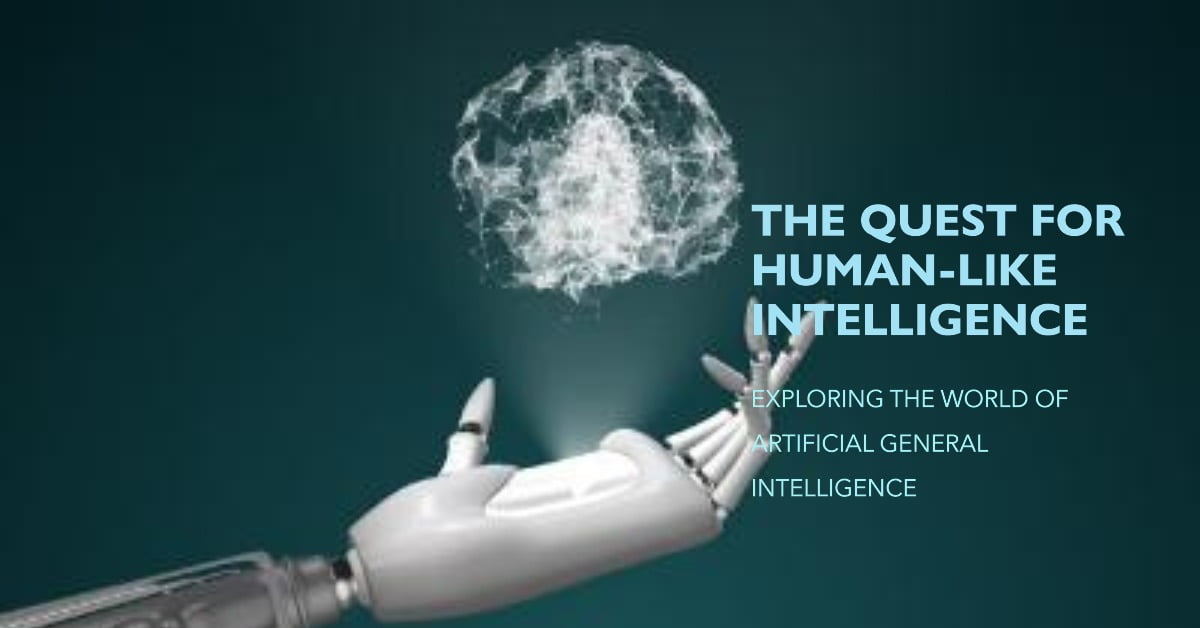Artificial General Intelligence
Table of Contents
In the area of Artificial intelligence (AI), the last aspiration is to create machines that possess intelligence on par with humans. This ambition offers an upward push to Artificial General Intelligence (AGI), a concept that transcends narrow AI packages and targets to copy the breadth and intensity of human cognitive abilities. In this complete manual, we discover the definition, historical context, characteristics, methods, and results of AGI.
Understanding Artificial General Intelligence (AGI)
Artificial General Intelligence, frequently known as “sturdy AI,” is a form of AI that is truly designed to own the subsequent developments:
- Human-like Intelligence: AGI seeks to duplicate human cognitive competencies, together with reasoning, trouble-fixing, learning, and flexibility.
- Versatility: Unlike narrow AI, which excels at particular tasks, AGI can perform an extensive range of high-brow obligations.
AGI represents the top of AI improvement because it strives to create machines that can apprehend, examine, and adapt across a large number of domains, much like an individual.
The History of AGI Research
AGI is not a recent idea, and its roots trace back to the mid-twentieth century.
- Alan Turing’s Influence: The pioneering paintings of Alan Turing laid the groundwork for AI and AGI. Turing’s conceptualization of a machine that might mimic human intelligence set the level for destiny studies in AGI.
- Early Research: Significant contributions have been made by early AI pioneers like John McCarthy and Marvin Minsky. They developed the primary AI packages and laid the groundwork for subsequent research.
AGI studies have their roots in the mid-20th century; however, they have gained momentum in recent years with improvements in gadgets, neural networks, and computational strength.
Characteristics of AGI
The key characteristics that outline AGI are:
- Learning: AGI structures can learn from experience, adapt, and improve their overall performance over the years. This function is important for AGI to be able to accumulate and follow expertise autonomously.
- Reasoning: AGI is capable of undertaking logical and summary thinking. It can follow policies of inference, deduce conclusions from premises, and assume severely.
- Problem-Solving: AGI can tackle complicated troubles and find creative answers. This feature allows AGI to analyze situations, identify challenges, and suggest solutions correctly.
The combination of getting to know, reasoning, and problem-solving abilities makes AGI a powerful and versatile form of AI that can address a vast spectrum of responsibilities and demanding situations.
Approaches to Achieving AGI
Researchers assign lots of strategies to the AGI method:
- Reinforcement Learning: This technique entails systems getting to know each other through trial and error and receiving feedback in the form of rewards. Reinforcement learning has been a hit in training AI sellers to play games, manipulate robotic systems, and make selections based on feedback.
- Symbolic Reasoning: Some researchers discover symbolic reasoning and know-how representation to replicate human-like thinking. In symbolic AI, information is represented via symbols and guidelines, allowing machines to reason symbolically and draw logical conclusions.
- Neural Networks: The application of neural networks, specifically deep learning, has proven promising in replicating positive components of human cognition. Deeply gaining knowledge of models, stimulated by the structure of the human mind, has led to incredible fulfillment in responsibilities consisting of image recognition, herbal language processing, and speech reputation.
Researchers regularly integrate those processes to develop hybrid AI structures that leverage the strengths of every technique. These hybrid models aim to capture the complexity of human intelligence by integrating studying, reasoning, and symbolic understanding.
The Future of AGI
The future of AGI is a topic of excessive speculation. As technology and AI research boost, the realization of AGI may become more workable.
- Technological Advancements: The journey towards AGI is tightly intertwined with technological advancements. Increasing computational electricity, better algorithms, and the right of entry to sizeable datasets have extended AI research. This progress has brought about giant breakthroughs in machine learning, reinforcement learning, and herbal language processing.
- Societal Impact: The emergence of AGI has the capability to revolutionize industries, reshape the workforce, and redefine the manner in which we stay and work. In healthcare, AGI ought to decorate diagnostics, drug discovery, and personalized remedy plans. In finance, AGI may enhance algorithmic trading, fraud detection, and customer service. In schooling, AGI can offer customized mastering experiences, propose tailored instructional content, and shape the future of school rooms.
- Ethical and Existential Concerns: The emergence of AGI poses ethical dilemmas and existential risks that deserve careful consideration. Questions about management, protection, and value alignment must be addressed to make sure AGI structures are advanced responsibly. Researchers and companies are actively exploring AI protection measures, fee alignment techniques, and strategies for ethical AGI development.
The direction to AGI is marked with the aid of exciting improvements; however, it additionally affords challenges that demand careful navigation. As AGI research progresses, addressing moral concerns and imposing strong AI safety protocols could be critical to reaping the full advantages of AGI while mitigating potential dangers.
Challenges and Ethical Considerations
The course for AGI is fraught with demanding situations.
- Control Problem: Ensuring that AGI systems behave as intended and align with human values is a powerful challenge. The manipulation problem pertains to the problem of directing AGI systems in a manner that ensures they act according to human choices and moral norms. Researchers are exploring mechanisms for manipulation, along with cost alignment and interpretability, to guide AGI systems correctly.
- AI Safety: Researchers and corporations have to prioritize protection in AGI improvement to save you from accidental results. Ensuring that AGI structures function competently and do not cause harm to human beings or society is a pinnacle priority. The research network is actively operating on methods for building safe and reliable AGI systems. This consists of the development of fail-safe mechanisms, robust testing, and the established order of ethical pointers for AGI studies.
The challenges associated with AGI development require close collaboration among researchers, businesses, and policymakers. The pursuit of AGI necessitates strong protection measures, ethical considerations, and worldwide cooperation to cope with shared worries.
Real-World Applications and Implications
AGI holds the capacity for transformative packages in various industries. The breadth and depth of AGI skills make it a promising candidate for addressing complicated, demanding situations and augmenting human information.
- Healthcare: In healthcare, AGI could revolutionize diagnostics, drug discovery, and personalized treatment plans. AGI systems can examine medical data, come across illnesses, suggest treatment alternatives, and even assist in surgical tactics.
- Finance: In the monetary quarter, AGI has the capacity to beautify algorithmic buying and selling, fraud detection, and customer support. AGI structures can process widespread monetary facts, become aware of market traits, and come across fraudulent activities.
- Education: AGI can provide customized reports, recommend tailor-made educational content material, and shape the future of lecture rooms. AGI-driven instructional structures can adapt to individual mastering patterns, provide real-time remarks, and provide personalized curriculum guidelines.
The implications of AGI extend beyond those industries, doubtlessly reshaping the manner in which corporations function, healthcare is delivered, and schooling is accessed.
FAQs
What is the primary goal of artificial general intelligence (AGI)?
The number one purpose of AGI is to create machines that have human-like intelligence and cognitive talents. Unlike slim AI, which focuses on specific obligations, AGI pursuits showcase versatility in knowledge, studying, and adapting across a huge variety of domains.
How does AGI differ from narrow AI?
Narrow AI is designed for specific responsibilities and excels in a restrained area. In comparison, AGI targets to replicate human-like cognitive capabilities and can perform an extensive variety of highbrow duties, similar to a person.
What are the moral worries surrounding AGI?
Ethical worries surrounding AGI encompass the potential for AGI systems to behave towards human pastimes, make self-sufficient decisions, and inadvertently cause damage. The responsible improvement of AGI consists of addressing AI protection, value alignment, and the ethical implications of AGI research.
In this journey into the world of artificial general intelligence, we’ve explored its definition, historical context, key characteristics, study techniques, and ability for real-world international applications. As technology advances, the belief in AGI promises to reshape our world, bringing both possibilities and ethically demanding situations.
With the future of AGI on the horizon, it’s vital to address the ethical worries, protection measures, and collaborative efforts needed to harness the total ability of AGI while making sure it advantages humanity as a whole. AGI isn’t always only a technological milestone; it represents a profound transformation to be able to contact every aspect of our lives.












3 thoughts on “Artificial General Intelligence (AGI): The Quest for Human-Like Intelligence”